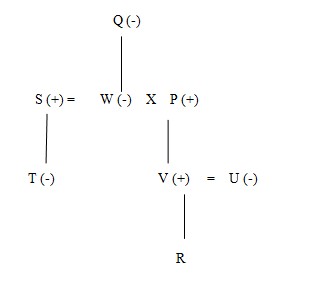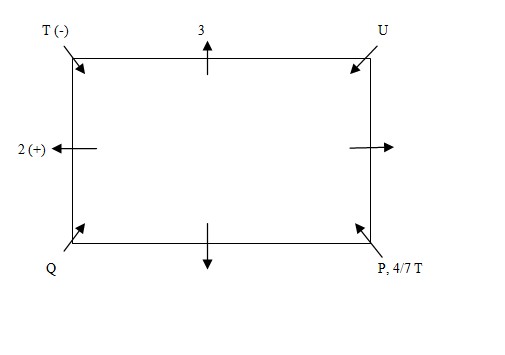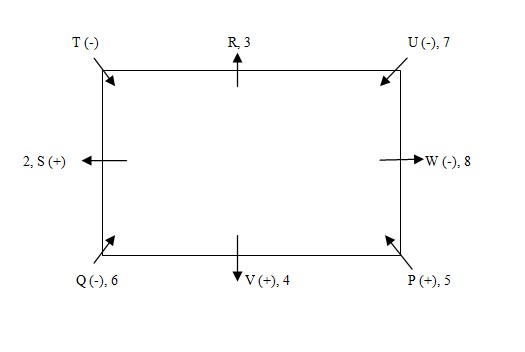Question
Four of the following five are like in a certain way and
form a group. Which of the following does not belong to that group? Read the following information carefully and answer the questions given below it: P, Q, R, S, T, U, V and W are sitting around a square table in such a way that four of them who sits at the corner are facing towards the centre and other four who sits in the middle of the table are facing outside the centre. Each person has different number of coins viz. 1, 2, 3, 4, 5, 6, 7 and 8, but not necessarily in the same order. Only one person sits between W and V. V sits second to the right of the person who has 8 coins. W’s brother S, sits on the immediate left of his mother who has 6 coin. P is the father of V and only one person sits between W’s mother and T. S’s daughter sits second to the right of U and on the immediate left of that person who has 3 coins. Q sits second to the left of W’s husband who has neither 4 nor 7 coins. U, who is sister of V, has 7 coins and is not an immediate neighbour of W’s husband. T sits on the immediate right of the person who has 2 coins. S’s daughter has 1 coin. Only one person is sitting between P and U. No female is an immediate neighbour of Q, who sits at the corner of the table. V is father of R and is not an immediate neighbour of T. P is married to W.Solution
W’s brother S, sits on the immediate left of his mother who has 6 coins. P is the father of V and only one person sits between W’s mother and T. U, who is sister of V, has 7 coins and is not an immediate neighbour of W’s husband. V is father of R and is not an immediate neighbour of T. P is married to W. By the statement ‘only one person sits between W’s mother and T’, we find that Q is W’s mother and T is S’ daughter.  No female is an immediate neighbour of Q, who sits at the corner of the table. Q sits second to the left of W’s husband who has neither 4 nor 7 coins. Only one person is sitting between P and U. S’s daughter sits second to the right of U and on the immediate left of that person who has 3 coins. T sits on the immediate right of the person who has 2 coins.
No female is an immediate neighbour of Q, who sits at the corner of the table. Q sits second to the left of W’s husband who has neither 4 nor 7 coins. Only one person is sitting between P and U. S’s daughter sits second to the right of U and on the immediate left of that person who has 3 coins. T sits on the immediate right of the person who has 2 coins.  S, sits on the immediate left of his mother who has 6 coins. V is not an immediate neighbour of T. So, V can sit at immediate right or immediate left to P. If V sits immediate right to P, and as we know that W is female so she sit at immediate left to T. We know that V sits second to the right of the person who has 8 coins. By this statement this condition is not possible. If V sits immediate left to P, so W will sit at immediate right to P. Then R will sit at immediate left to T. Further V sits second to the right of the person who has 8 coins. It is given that T has 1 coin and that of U is 7. So V will have 4 and P will have 5 coins
S, sits on the immediate left of his mother who has 6 coins. V is not an immediate neighbour of T. So, V can sit at immediate right or immediate left to P. If V sits immediate right to P, and as we know that W is female so she sit at immediate left to T. We know that V sits second to the right of the person who has 8 coins. By this statement this condition is not possible. If V sits immediate left to P, so W will sit at immediate right to P. Then R will sit at immediate left to T. Further V sits second to the right of the person who has 8 coins. It is given that T has 1 coin and that of U is 7. So V will have 4 and P will have 5 coins 
A man spends 25% of his monthly salary on Rent and 32% on Groceries. He invest remaining monthly salary in the ratio of 11: 5 in Mutual Funds and Fixed ...
- X is 40% less than Y and Z is 30% more than W. If W is 25% more than X, then which of the following is true?
- The score of Aman is 20% more than Ramesh. Karan's score is 110 more than the difference between Aman and Ramesh. If Karan scored 210 marks, find the marks...
- A man received Rs. 15,000 as a bonus. He spent 25% of this on groceries, 10% of the remaining on clothes, and 20% of the remaining on travel. What amount o...
Rahul secured 32% marks in an exam and fell short by 48 marks. Kunal secured 47% marks in the same test and scored 27 marks more than the passing marks....
- A college had 5500 students in 2018, with 68% of them being girls and the remaining boys. In 2019, the number of girls increased by 40% and the number of b...
A factory produces 800 units of product A in 5 days. If the production rate increases by 25% after 3 days, how many days will it take to produce a total...
The salary of A is 40% more than B, and the bonus of C is 150 more than the difference of the salaries of A and B. If C receives a bonus of 270, find A'...
A Fruit seller purchased 1530 bananas at the rate of Rs. 20 per dozen. 90 bananas get rotten. In order to make a 20%, he must sell the remaining bananas...
S's income is 60% higher than T's. S and T save 30% and 20% of their incomes respectively. If S spends Rs. 720 more than T, what are S's savings?


